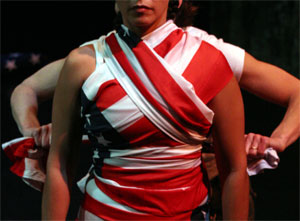After the Flaw There Is the Living With It: “Have Gun Will Shoot”
Lightsey Darst reviews Have Gun, Will Shoot, by Rosy Simas Dance Projects at the Red Eye. Her thoughts on if, and how, artists can influence the conduct of politics are arresting.

It turns out that humans are flawed. The source of the flaw—original sin, fear of death, misunderstanding, inequality, pure evil—can’t be definitely pinned down, but the flaw itself can’t be denied after this past hundred years: witness the Holocaust, the atom bomb, genocide in this and that country, and all the old atrocities (murder and robbery of Native Americans, oppression of women, slavery) that are finally being acknowledged. Not only do we know now that we are flawed, but we are able to watch our flaw in action daily: war continues, hate continues, greed ruins half the world. The natural reaction to all this is sadness, and outrage.
Rosy Simas’s “Have Gun Will Shoot” rolls on these emotions. This protest against war begins with blind allegiance to the American flag and then shows how troubled this flag is with a series of provocative images. Soldiers destroy themselves in preparation for destroying others; Simas, tightly wrapped in flags, staggers and pulls at the starry restraint; soldiers bring out piles of triangle-folded flags, representing the dead, then continue their fight; Simas sings a folksy protest song (“why have you come / to trade the fiddle for the drum”), looking sometimes at a huge American flag hanging off to the side, sometimes directly at the audience. War is hell, Simas tells us bluntly.
But then what? There are tragedies and there are tragedies, and after the flaw there is the living with it, which strikes me as more interesting and potentially more powerful than simply protesting war. After all, here we are, breathing and writing and drinking wine, attending anti-war performances which have no chance of being shut down by that government we do not entirely approve of, eagerly anticipating our tax return so that we may take a vacation and gather more artistic inspiration, perhaps in France, which we still worship despite its terrible history and current cultural struggles.
I present this—is it even a dilemma?—because we are in a more complex age than the 1960s, and it is no longer sufficient to present accomplished truths to audiences of like-minded people. If a flag is theatrically dragged across the floor (technically, an act of desecration which requires the so-dishonored flag to be burnt) before a crowd of liberals, did it happen at all? And if a conservative somehow happens to stumble into a dance performance and witness flag desecration, will he be convinced, or merely repulsed? Irony and the personal, both lacking from “Have Gun Will Shoot,” dominate our age. By ignoring the first, Simas leaves herself open to parody; by neglecting the second, she shuts the door on rich and unexamined material. I’ll go further: that pile of folded flags, which appears on stage as the solemn cost of war, represents so many individuals who should not, now that they are dead, be forced to stand for anything. They are not our dead, to be invoked in various causes; they are their own. The opposition may not know better, but we do.
Call it a philosophical difference. My belief that the straight protest is outdated doesn’t change the fact that Simas offers a hearty entry in this category, or that Simas delivers her damning indictment through a well-made combination of dance, song, music (engineered by Mark Ruark), costumes, props, and projected visuals (created by Patrick Maun). “Have Gun Will Shoot” unfolds almost as a series of tableaux vivants, each scene opening with a new battery of effects. Two soldiers grieve between the pile of folded flags and the hanging flag while a red Statue of Liberty bleeds over a camo background; Simas stalks out in a gas mask, holding a rifle, her shadow like a second person stalking her; soldiers roll and duck while techno thrashes and a strangely horrific image of human nerve endings plays behind. Simas combines these elements well. She’s also assisted by sincere and powerful dancing (particularly from Leslie O’Neill and Kellie Brandt).
But the fixed meaning of “Have Gun Will Shoot” robs the dancing of its importance. Scenes, once begun, rarely evolve; as with a tableau vivant, when the lights come up, you’ve seen all that you’re going to see. Simas’s tight scheme keeps “Have Gun Will Shoot” from discovering, from moving beyond its origin. Only in one scene is meaning uncertain—a strange, melancholy duet between two soldiers, one pulling away and the other supporting. Here I was forced to watch the dance to understand what was happening. It’s a vulnerable spot in a subtlety-proof evening—and won’t vulnerability, not polemic, be the new protest?